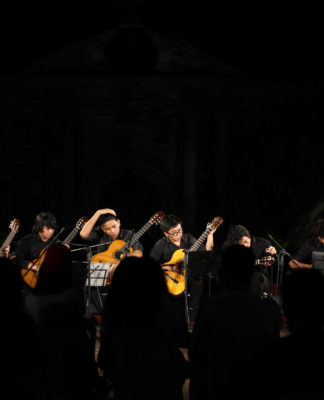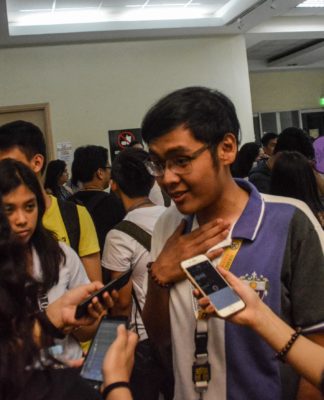
(Lumad youth performing a cultural dance. Photo by Alhex Adrea M. Peralta)
November 7, 2015, 11:14a.m. – LEADERS of Mindanao’s indigenous tribes urged the Thomasian community to support their fight to attain peace and justice amid extrajudicial killings.
“Kailangang magkaroon ng awareness ang mga mamamayan upang kami ay matulungan na makamit ang kapayapaan laban sa karahasan,” said Dulphing Ogan, secretary general of the Kusog sa Katauhang Lumad sa Mindanao (Kalumaran), a confederation of indigenous tribes.
He attributed the killings to the Lumad resistance to mining operations and the expansion of agricultural plantations in Mindanao.
“Kapag hindi namin ipinaglaban ang aming lupa, paano na ang kabataan sa amin [?] Mahalaga ang lupa para sa isang tribo. Kami rin ay naniniwala na ang likas na yaman ng bansa ay dapat sa bansa napupunta,” Ogan said in a forum last Nov. 4 at the Benavides Auditorium.
Mark Anthony Abenir, director of the UST Simbahayan, said the University was one with the Lumad in their fight for justice and peace.
“Bilang Katolikong pamantasan, ang ating adhikain na itaguyod ang karapatang pantao ay hindi nalalayo sa adhikain ng mga Lumad na ipaglaban ang kanilang lipunan,” Abenir said in an interview.
Land grabbing in Mindanao
Joan Jaime, member of the Kalipunan ng mga Katutubong Mamamayan ng Pilipinas (KKMP), said mining in Mindanao had resulted in violations of human rights and the indigenous peoples’ rights to ancestral domain.
KKMP, an organization that seeks to attain “genuine ancestral land rights” and self determination for indigenous peoples, has recorded around 200 extrajudicial killings since 2010 that may be related to mining activities.
“Kaya pinapatay ang mga Lumad leaders dahil ayaw nilang hayaan ang mga mining companies na magtayo ng land mines sa ancestral lands nila. Sila ‘yung target kasi sila ‘yung lumalaban,” Jaime said.
The Philippine Mining Act of 1995 allowed foreign companies to fully own mining operations in the Philippines. A total of 721 mining companies are operating in the different regions of the country and more are still applying for permits.
Aside from the extrajudicial killings of the Lumad, other human rights violations recorded were the bombing of indigenous territories, mass evacuation of tribes and the illegal arrests of tribe leaders.
Fr. Gallardo Bombase, O.P., vice rector for religious affairs, said land is important for the Lumad for it is part of their ancestral heritage.
“Your land is your life. Kapag inalis pa ang lupa, wala nang pwedeng mabuhayan,” he said. “Kaya anumang mangyari, ipaglaban mo ‘yan dahil kabilang ‘yan sa pagtatanggol ng karapatang pantao.”
Photo exhibit
The “Dialogue of Life: Continuing Journey with the Anawim (Rural People)” is an effort of the University to reach out to the marginalized natives of Mindanao, composed of a series of events for the Lumad.
Abenir said the event was meant to raise awareness on the discrimination on the Lumad and support for the programs spearheaded by the Simbahayan.
The Lumad Advocacy Photo Exhibit, displayed at the España covered wall, will be open from Nov. 4 to Dec. 8. The Lumad Gift Giving will be at Liwasang Bonifacio in Manila on Nov. 15. Amierielle Anne A. Bulan and Alhex Adrea M. Peralta















